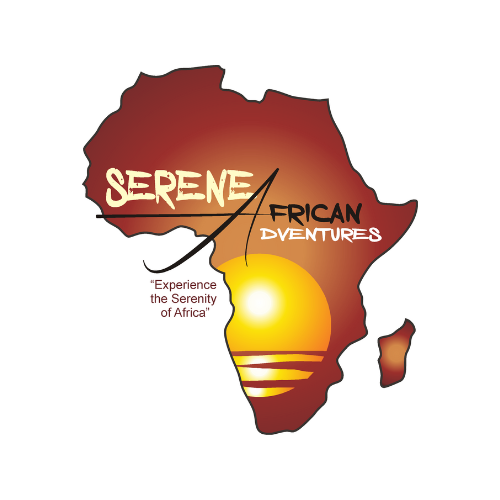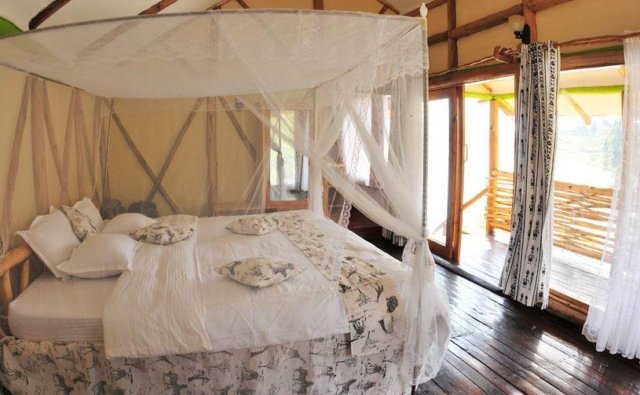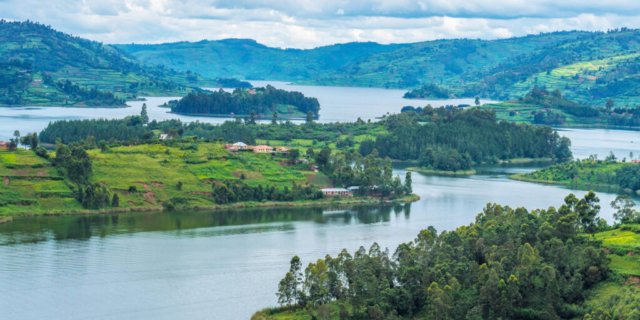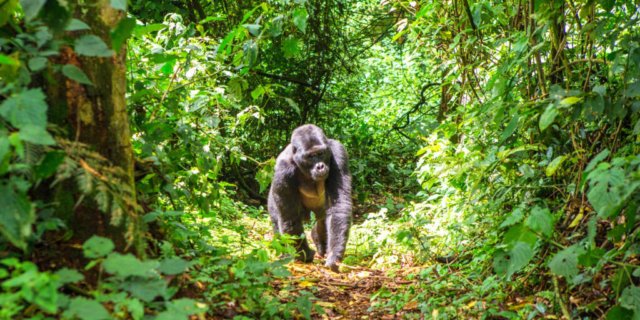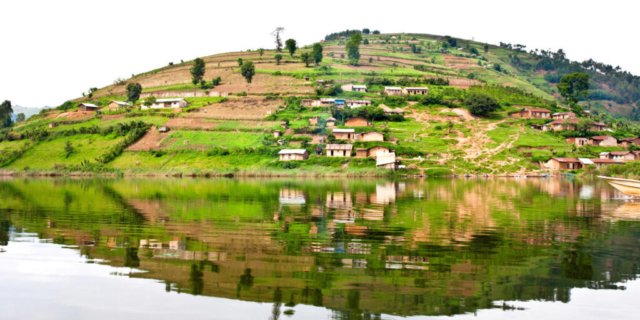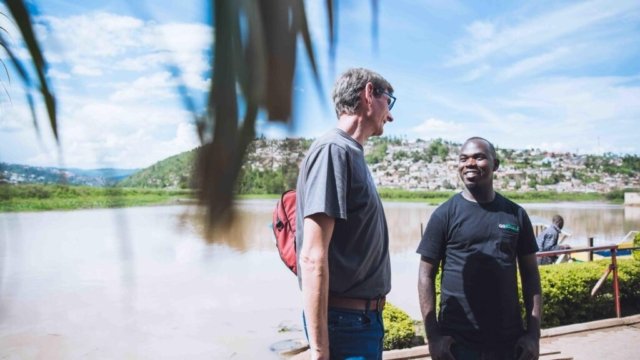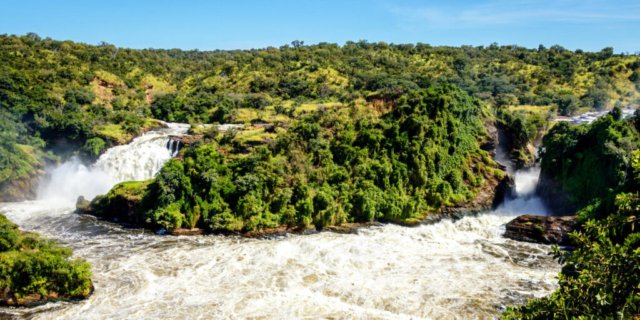Uganda
Explore Uganda
Uganda may be small in comparison to some of its neighbouring countries however ‘the pearl of Africa’ certainly has a lot of offer to the visitor. There are many reasons why you should think about visiting this extraordinary country for your next holiday, but here are just five to get you started.

Why Visit Uganda
1. The Gorillas
Uganda is one of only three countries in the world where you can see the highly endangered mountain gorilla in the wild (only an estimated 900 remain). The two gorilla trekking spots in Uganda are Bwindi Impenetrable Forest National Park and Mgahinga Gorilla National Park. Gorillas don’t pay mind to political borders, so populations across the Virungas are relatively fluid. Uganda has an edge, however, since Bwindi alone is home to half of the world’s mountain gorillas. It is also important to note that unlike its neighbour Rwanda, Uganda has not increased the price of its Gorilla permits, so one can trek twice in Uganda for the price of one trek in Rwanda! The best time for trekking in Uganda is between the months of December to late February, and the months of June to September, as these are the driest months of the year.
2. The Wildlife
When it comes to wildlife, there’s more to Uganda than just mountain gorillas. Its 10 national parks and several game reserves are also home to the likes of elephants, hippos, zebras, lions, leopards and over a 1000 species of birds. One of the best places to see Uganda’s other wildlife is Queen Elizabeth National Park in the south west of the country. Established in 1952, it boasts a high level of biodiversity and a wide variety of landscapes including savannah, bushland, wetlands and lush forests. The remote Ishasha sector, in the far south of the park, is also home to tree climbing lions!
3. The Scenery
Uganda punches well above its weight in the breath-taking scenery department. To the west is the glacier-capped Rwenzori mountain range, romantically labelled the ‘Mountains of the Moon’. To the south is Lake Victoria, the second largest freshwater lake in the world and main reservoir of the Nile. Speaking of the world’s longest river, it flows the length of Uganda from the aforementioned Lake Victoria in the south to the rolling grasslands of the north and across the border into South Sudan. Aside from those three heavyweights, Uganda is also home to dense forest, verdant wetlands and open plains, all of which are incredibly lush and support a diverse eco-system of flora and fauna.
Queen Elizabeth National Park (QENP, or Queens) is Uganda’s most visited national park and is often paired with Gorilla trekking in Bwindi and/or Chimp trekking in Kibale Forest. The park is famous for its big cats, including tree-climbing lions and leopards. Game drives in will reveal the parks range of big game including elephants, buffalos, antelopes and warthogs.
Bwindi Impenetrable National Park was not home to the Mountain Gorilla, its remoteness, natural beauty and enthralling biodiversity would attract visitors. But it is those magnificent great apes that have made Bwindi Uganda’s single most important tourist destination. Coming face to face with mountain gorillas in their natural habitat is one of the most powerful and humbling wildlife encounters possible
the Nile squeezes through an 8m wide gorge and plunges with a thunderous roar into the “Devil’s Cauldron”, creating a trademark rainbow. The northern section of the park contains savannah and Borassus palms, acacia trees, and riverine woodland. The south is dominated by woodland and forest patches. Murchison Falls National Park lies at the northern end of the Albertine Rift Valley, where the sweeping Bunyoro escarpment tumbles into vast, palm-dotted savannah. First gazetted as a game reserve in 1926, it is Uganda’s largest and oldest conservation area. The park is bisected by the Victoria Nile, which plunges 45m over the remnant rift valley wall, creating the dramatic Murchison Falls, the centrepiece of the park and the final event in an 80km stretch of rapids. The mighty cascade drains the last of the river’s energy, transforming it into a broad, placid stream that flows quietly across the rift valley floor into Lake Albert. This stretch of river provides one of Uganda’s most remarkable wildlife spectacles. Regular visitors to the riverbanks include elephants, giraffes, and buffaloes; while hippos, Nile crocodiles, and aquatic birds are permanent residents.
Lake Mburo National Park stands as an interesting attraction in Uganda with diverse colour and habitat. Although the park stands as one of the smallest national parks the abundance of wildlife and rich habitat makes it alive. You can discover the lakes and forest galleries, the swaps and wetland, acacia vegetation and valleys with grasses dominating the topography. The entire regions boast a wealthy wilderness that supports 325 species of birds and the highest concentration of wilds in Uganda. It is recorded as the only national park where you can find impala, eland and klipspringer. Wildlife here includes leopards, buffalo, zebra and waterbuck, Hyena, white-tailed mongoose and a lot of nocturnal. Birdlife here includes the species of red-faced barbets and the African finfoots, papyrus yellow warblers and lot more. Not just the wilderness but the topography of the region is too diverse to make it a wonder of nature. The land there is dominated by the dry hillsides, bushy thickets, rocky outcrops, open and wooded savannah etc that supports the wilderness there. Lake Mburo, in the centre of the park Lake Mburo, forms part of a wetland along with 14 other lakes in Lake Mburo National Park. Adventure and thrill can be experienced here while cruising on the lake or going for a game drive. The hippos and crocodiles can be spotted floating on the lake.
Igongo cultural centre is a famous tourist spot that has attracted tourists from all across the globe. This cultural centre highlights the tribal life of Southwestern Uganda making it one stop destination for all kind of travelers. It also has a vast collection of artifacts, exhibits of agrarian and pastoral culture, history of political changes of the present day situation in the region. Opened I 2011 by then Ugandan president Museveni, this cultural centre promotes the rich culture and heritage of the region allowing the visitors to get a glimpse of the past and present history of Uganda. Take a de tour of the in house Eriijukiro museum that takes for about half an hour and showcases the evolution of Nyankore and Kigezi households. This spectacular museum is part of this cultural centre and encompasses state of the art facilities for the visitors. You can even indulge in afternoon sessions with the local tribal people and get to know more about their diverse culture and heritage. Spend your day at a cow farm and try hands on milking experience that will make your tour memorable. The in-house restaurant serves local Bahima and Ugandan food that should be tried while on your trip to the cultural centre. To learn about these tribal people can be challenging as well as life changing experience for all kinds of travelers.
Mgahinga National Park is one of the major attractions for tourist in Uganda. Lying towards the southwestern corner of the country, the national park is enclosed by the Volcanoes National Park of Rwanda and the Virunga National Park of the Democratic Republic of Congo. The region covers the forested area of three extinct volcanoes of Uganda and endemic flora and fauna. The national park houses around 79 bird species, 39 species of mammal and sparse vegetation of the montane forest. The wilderness includes the family of the mountain gorilla, buffalo and elephant. One can spot the rare golden monkey and the blue monkey along with the species of the golden cat, leopard, spotted hyena, side-striped jackal, black-fronted duiker, bushbuck and giant forest hog. The wildlife of Mgahinga National Park is known for the critically endangered and rare species that one may not see elsewhere in the African region or other parts of the world. It’s the volcanic mountains that add on to the aesthetic beauty making it the most biodiverse region of Uganda. Along with the extinct volcanos, there are indigenous Batwa pygmies dwelling there that exhibit the tribal culture of Uganda.
Surrounded by the peaceful waters of Lake Victoria, Ngamba Island Chimpanzee Sanctuary is home to 52 orphaned and rescued chimpanzees. Chimpanzee Sanctuary and Wildlife Conservation Trust (Chimpanzee Trust), an NGO, is responsible for all aspects of the sanctuary. Deeply committed to and involved in both field conservation and community education, we work closely with the Ugandan government and wildlife authorities. We offer both day Trips (Half and Full day) and overnight at Ngamba Ecolodge to the sanctuary which provides an exceptional opportunity to closely observe these fascinating great apes in our unique setting.
Rwenzori Mountains National Park is a Uganda National Park, in the Rwenzori mountains. The park is located in Southwestern Uganda, and has Margherita peak, which is Africa’s third highest, for which it is famous.The Rwenzori mountains National Park in southwestern Uganda, was gazetted in 1991, became UNESCO world heritage site in 1994 as well as a ramsaar site in 2008. The Park also provides great opportunities to seeing nature at its finest. Its plant life diverges from dense tropical rain-forest, bamboo woodlands, montane cloud forests to high-altitude vegetation and the decor is correctly outstanding. Beyond 4,500 meters, the snow and glaciers complement that special element to the astonishing views throughout this unspoiled mountain range. This park is mostly famous for mountaineering, trekking, hiking and climbing excursions or safaris with or without summiting the Margherita.
Rwenzori mountains national Park Guide offers you all you need to know about the magnificent Mountains of the Moon, how to get to the Park, the Best time to Visit the Park, Trekking routes/trails (Kilembe, Central circuit or Burungu), attractions, Rwenzori mountain peaks, lodge and hotel accommodations within or outside the park, Suggested Rwenzori Trekking Tour Operators, as well as what to wear/what to pack?(rwenzori mountaineering gear/equipment).
Lake Victoria is the largest African Great Lake by area, the world’s largest tropical lake, and the second largest fresh water body in the world. The lake has gone through major changes in biodiversity, and has been the site of the most development and conservation projects, both failures and successes, of all the African Great Lakes. Lake Victoria was formed about 400,000 years ago, and lies 1,134 m above sea level. It has a surface area of 68,800 km2, an average depth of 40 m, a maximum depth of 80 m, a volume of 2,760 km3, and a basin area of 195,000 km2, which extends to Rwanda and Burundi. The shoreline is shared by Kenya (6%), Uganda (43%), and Tanzania (51%). The Kagera, Katonga, Sio, Yala, Nyando, Sondu Miriu, and Mara rivers feed the lake and the River Nile carries water out of the lake.
also known as Mount Muhavura, is an inactive volcano in the Virunga Mountains on the border between Rwanda and Uganda. At 4,127 metres Muhabura is the third highest of the eight major mountains of the mountain range, which is a part of the Albertine Rift, the western branch of the East African Rift
